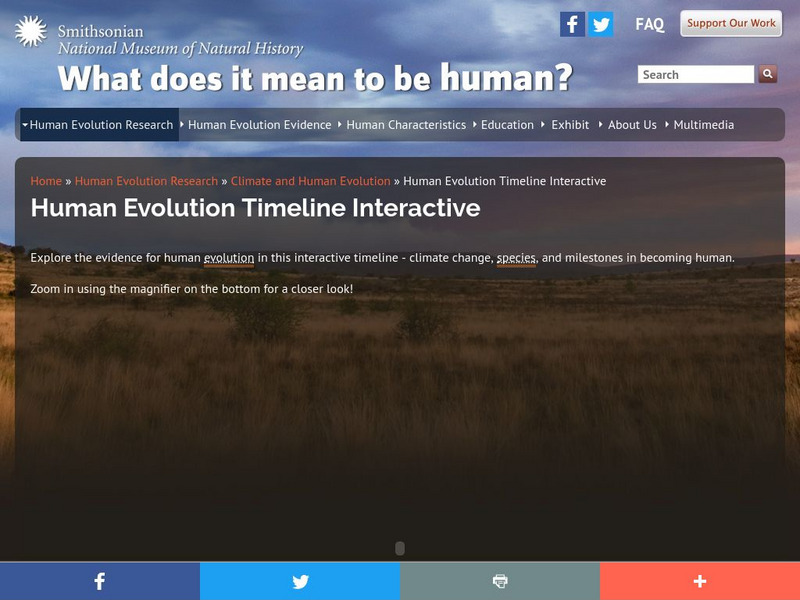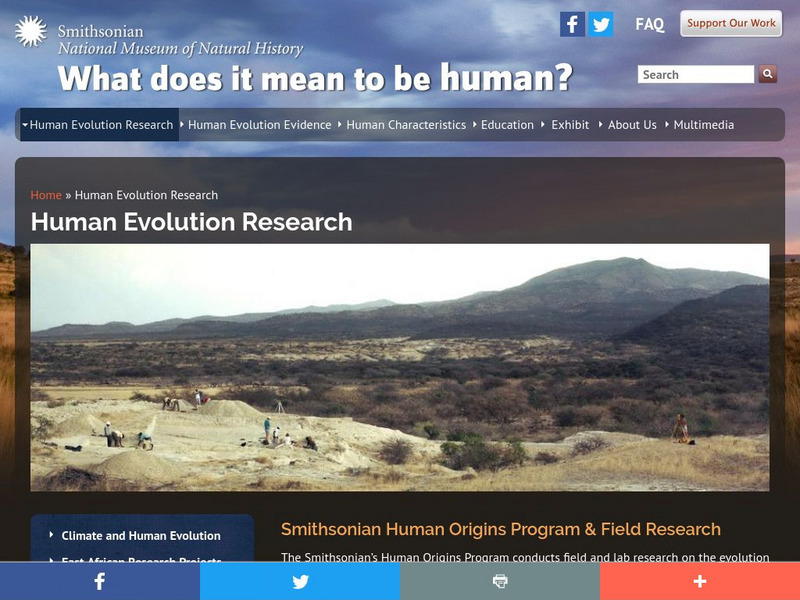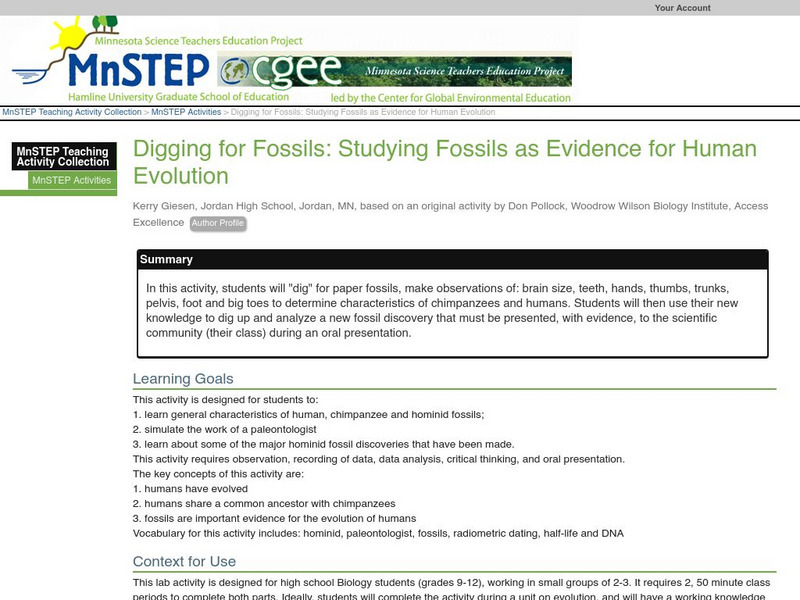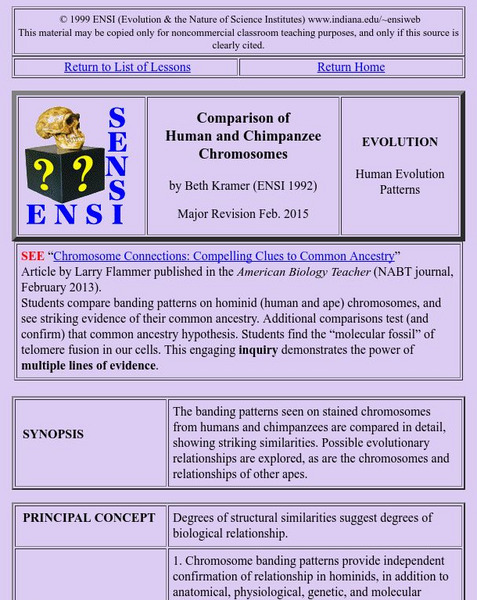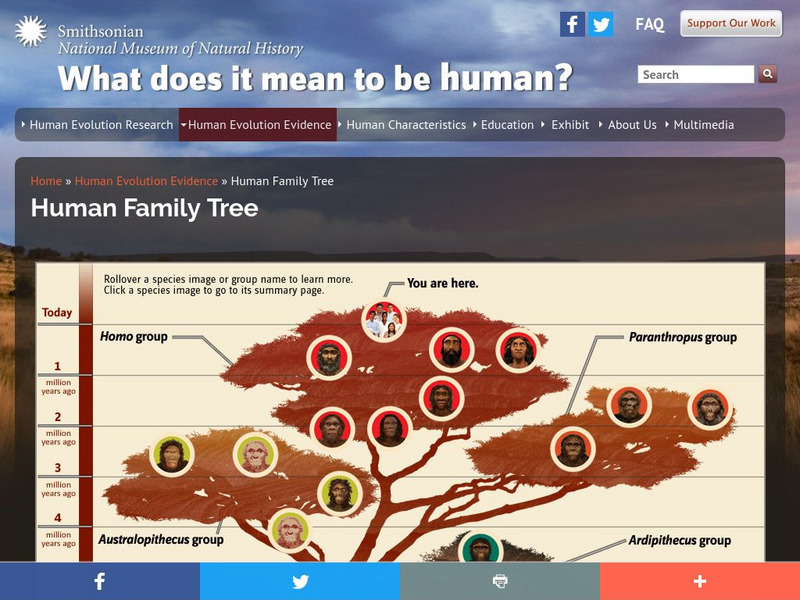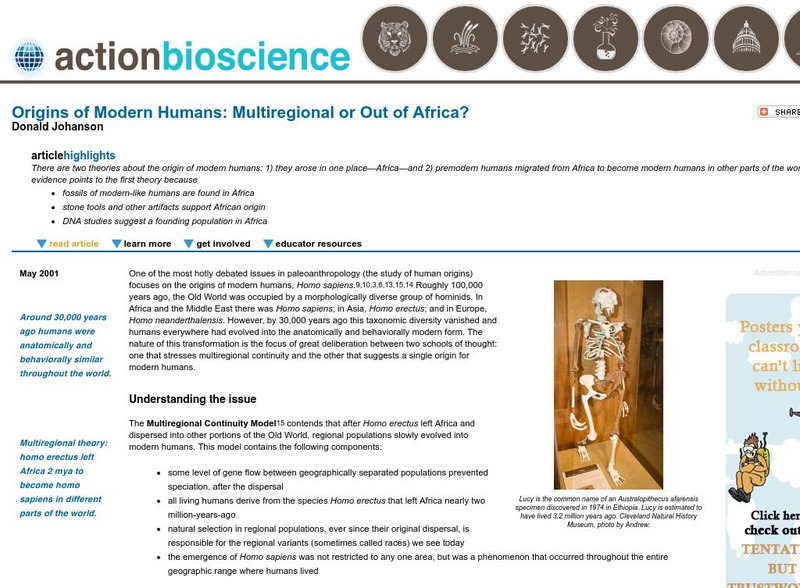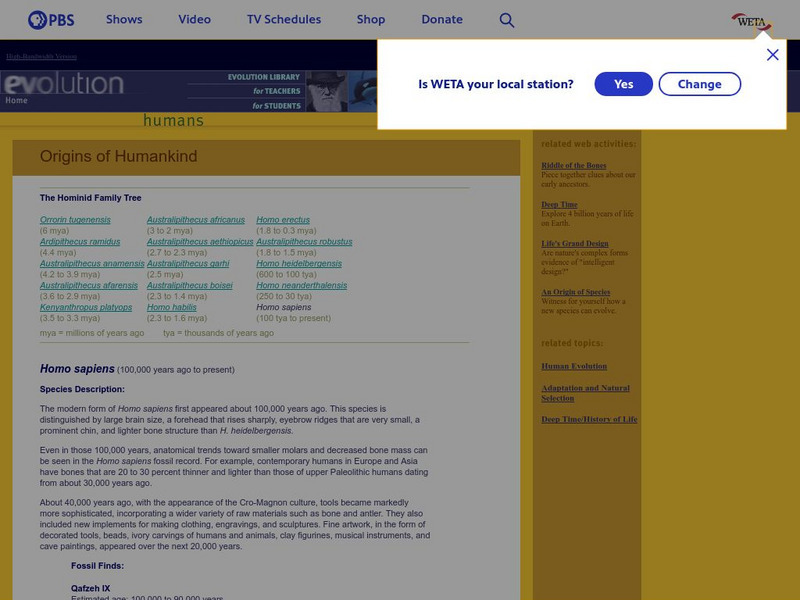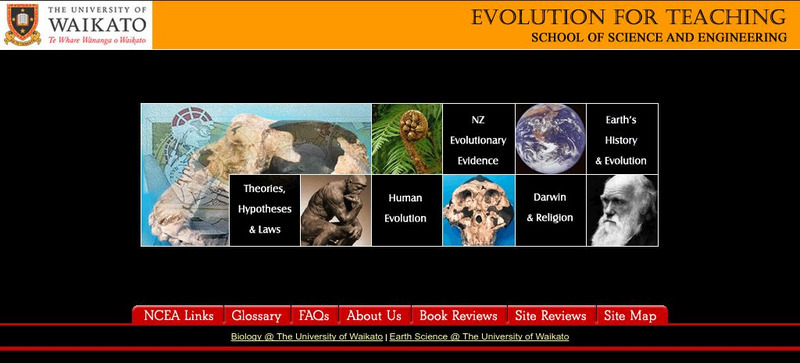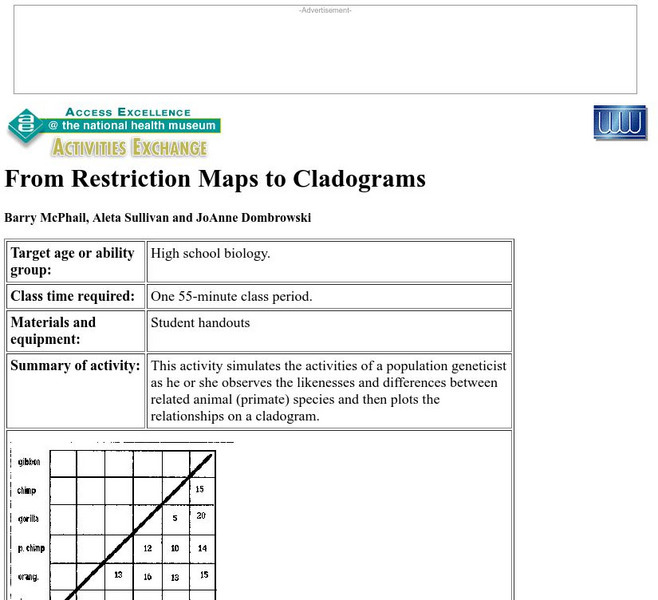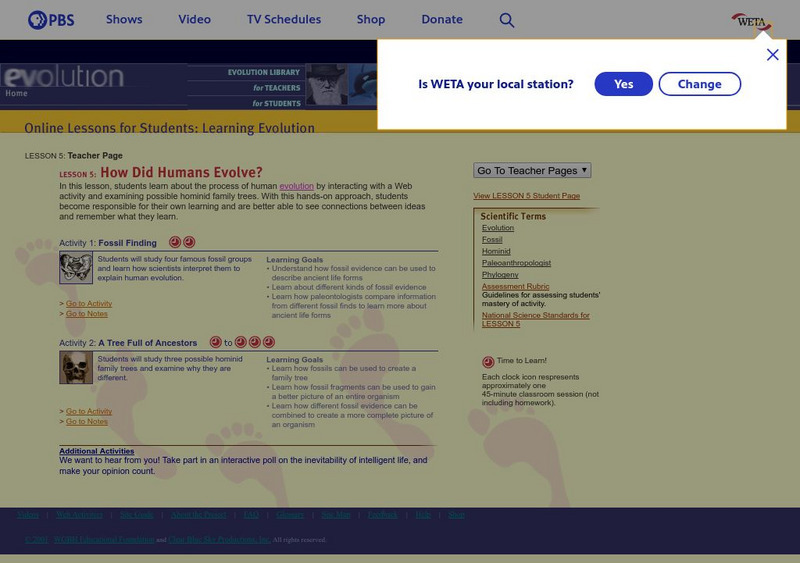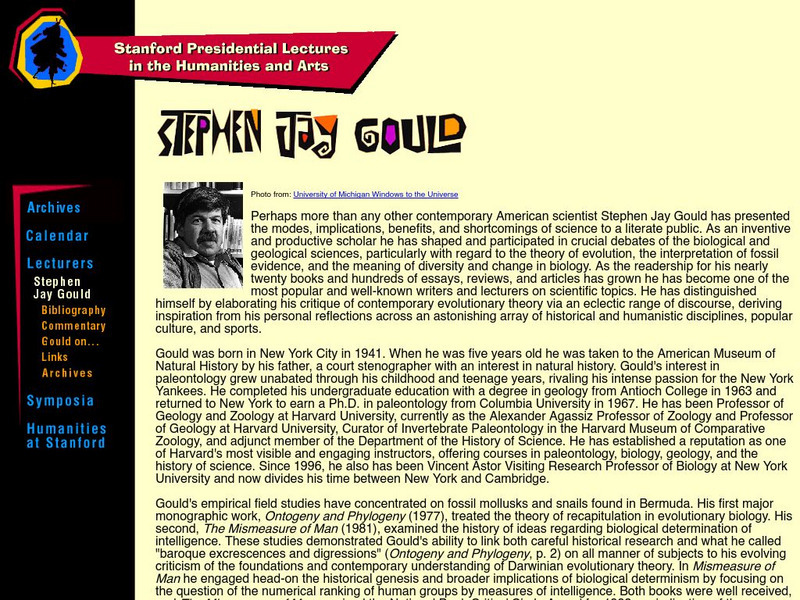Hi, what do you want to do?
Smithsonian Institution
National Museum of Natural History: Human Evolution Timeline Interactive
Explore the evidence for human evolution in this interactive timeline - climate change, species, and milestones in becoming human. During the period of human evolution, the Earth's climate has fluctuated between warm and cold. Some of...
Smithsonian Institution
National Museum of Natural History: What Does It Mean to Be Human: Human Evolution Research
Research continues to discover evidence left behind by prehistoric man. Discover the climate effects on human evolution and explore how the adaptable survived. The Asian and East African Research Projects in Kenya are described. You,...
Science Education Resource Center at Carleton College
Serc: Digging for Fossils: Studying Fossils as Evidence for Human Evolution
As students dig for paper fossils, they make observations of brain size, teeth, hands, thumbs, trunks, pelvis, foot and big toes to determine characteristics of chimpanzees and humans. Then, they dig up and analyze a new fossil...
Indiana University
Ensi: Comparison of Human: Chimpanzee Chromosomes Lesson
This is a great lesson plan that combines Karoytypes and evolution. Learners will recognize that the chromosomes of chimpanzees and humans are remarkably similar, then correlate that to their evolutionary relationship.
Khan Academy
Khan Academy: Answers to Exploration Questions: Human Evolution
On this site, find answers to the exploration activity on human evolution. Questions discuss both physical traits of hominid as well as DNA evidence.
Other
E Fossils: Step by Step: Evolution of Bipedalism
In this tutorial, students will identify the fossil evidence for the evolution of bipedalism then hypothesize about the evolutionary pressures affecting bipedal behavior.
Smithsonian Institution
National Museum of Natural History: Human Origins: Human Family Tree
Find the human ancestor you are interested in and click on it either in the timeline or the list below for more details. Each fossil or reconstruction pictured includes links to more details about it.
American Institute of Biological Sciences
Action Bioscience: Origins of Modern Humans: Multiregional or Out of Africa
Two migration theories are on the table for consideration. Weigh the evidence of each one in this article by Donald Johanson of Lucy fame.
Khan Academy
Khan Academy: Charles Darwin's Evidence for Evolution
An article reviewing over the life of Charles Darwin and his evidence of evolution. Find out how this young naturalist who took a trip around the world collecting evidence about how organisms have changed over time.
PBS
Pbs Learning Media: Riddle of the Bones
At the online companion Web site of "Evolution," the seven-episode series on PBS, piece together clues to how one of our early ancestors looked as you examine images from four significant fossil finds of Australopithecus afarensis.
PBS
Pbs Learning Media: Life's Grand Design
Are nature's complex forms evidence of "intelligent design"? In this Evolution essay, biologist Kenneth Miller explains how the processes of evolution account for complex structures such as the human eye.
PBS
Pbs: Evolution: Origins of Humankind: Homo Sapiens
Read a description of Homo sapiens as a species, learn about the variety of Homo sapiens fossils that have been found, and discover evidence of the culture of these early people.
Smithsonian Institution
National Museum of Natural History: Homo Habilis
This resource provides graphics, as well as explanation, of the remains of Homo habilis.
Other
Evolution for Teaching: School of Science and Engineering
A reference page containing information related to evolution. Topics discussed on the page is the theories, human evolution, evolutionary evidence, Darwin, and Earth's history.
CK-12 Foundation
Ck 12: Life Science: Molecular Evidence for Evolution
[Free Registration/Login may be required to access all resource tools.] Chimpanzees and humans turn out to be very similar - if you look at their DNA. When scientists determined the entire genetic code of both humans and chimpanzees,...
Curated OER
Unesco: Israel: Sites of Human Evolution at Mount Carmel
Situated on the western slopes of the Mount Carmel range, the site includes the caves of Tabun, Jamal, el-Wad and Skhul. Ninety years of archaeological research have revealed a cultural sequence of unparalleled duration, providing an...
Other
The Cave of Chauvet Pont D' Arc
The only way to see the prehistoric cave paintings at Chauvet-Pont-D' Arc, France is to take the virtual tour offered here. Learn about the discovery of the caves and the archaeological evidence found that allows great insight into the...
Curated OER
Unesco: Ethiopia: Lower Valley of the Awash
The Awash valley contains one of the most important groupings of palaeontological sites on the African continent. The remains found at the site, the oldest of which date back at least 4 million years, provide evidence of human evolution...
National Health Museum
Nhm: Restriction Maps to Cladograms Lesson
This lesson plan requires students to analyze DNA restriction maps to determine the differences in the sequence for several primates and humans. They then use the information to create a cladogram.
National Health Museum
Access Excellence: Molecular Biology/primate Phylogeny
This lesson plan involves comparison of amino acids to create a phylogenetic tree of primates. Students will also use other species information to draw conclusions about evolutionary relationships.
PBS
Pbs Teachers:how Did Humans Evolve?
Explore paleoanthropology by going on a virtual "dig" to answer questions about famous fossil finds. Explain how alternate hominid family trees result from different interpretations of the same fossil evidence.
Curated OER
Unesco: Tanzania: Ngorongoro Conservation Area
The Ngorongoro Conservation Area spans vast expanses of highland plains, savanna, savanna woodlands and forests. Established in 1959 as a multiple land use area, with wildlife coexisting with semi-nomadic Maasai pastoralists practicing...
Stanford University
Stanford Presidential Lectures: Stephen Jay Gould
Standford University provides interesting biographical and professional information on Stephen Jay Gould and his many contributions to scientific thought, including his efforts to help people see science "As something that is important...
Curated OER
Unesco: Thailand: Ban Chiang Archaeological Site
Ban Chiang is considered the most important prehistoric settlement so far discovered in South-East Asia. It marks an important stage in human cultural, social and technological evolution. The site presents the earliest evidence of...





